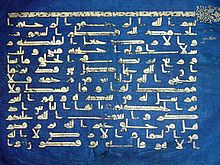Islamic manuscripts
Islamic manuscripts were produced in different ways depending on their use and time period. Parchment (vellum) was a common way to produce manuscripts.[1] Manuscripts eventually transitioned to using paper in later centuries with the diffusion of paper making in the Islamic empire. When Muslims encountered paper in Central Asia, its use and production spread to Iran, Iraq, Syria, Egypt, and North Africa during the 8th century.[2]
Scripts[]

The development of scripts in the Islamic empire, demonstrates the transition from an oral culture to convey information to written. Traditionally speaking in the Islamic empire, Arabic calligraphy was the common form of recording texts. Calligraphy is the practice or art of decorative handwriting.[3] The demand for calligraphy in the early stages of the Islamic empire (circa 7–8th century) can be attributed to a need to produce Qur'an manuscripts. During the Umayyad period, Kufic scripts were typically seen in Qur'an manuscripts.[3]
Genres[]
Islamic manuscripts include a variety of topics such as religious, medical, astrological, and literature.
Religious[]

A common religious manuscript would be a copy of the Qur'an, which is the sacred book of Islam. The Qur'an is believed by Muslims to be a divine revelation (the word of god) to the prophet Muhammed, revealed to him by Archangel Gabriel.[4] Qur'anic manuscripts can vary in form and function. Certain manuscripts were larger in size for ceremonial purposes, others being smaller and more transportable. An example of a Qur'an manuscript is the Blue Qur'an. The Blue Qur'an is ceremonial in nature, which a Hafiz would utilize. It has gold Kufic script, on parchment dyed blue with indigo.[5] Many Qur'an manuscripts are divided into 30 equal sections (juz) to be able to be read over the course of 30 days.[6] The Chinese practice of writing on paper, presented to the Islamic world around the 8th century, enabled Qur'ans to begin to be written on paper. The decrease in production costs of Qur'an manuscripts due to the transition from parchment to paper enabled Qur'ans to be utilized more frequently for personal use/worship, rather than just ceremonial settings.[3]
Scientific[]

Many early illustrated Arabic manuscripts are affiliated with scientific subjects. Scientific manuscripts discuss a variety of topics including but not limited to astronomy, astrology, anatomy, botany, and zoology.[7] The development of early illustrated scientific manuscripts began under the Islamic Abbasid dynasty in Baghdad in approximately the mid-8th century. The development of new scientific work starting to translation of old Greek scientific and learned works, and the make pure original scholarship in science, medicine, and philosophy in Arabic.[8] An example of an Arabic scientific manuscript is the Book of the Fixed Stars by Abd al-Rahman al-Sufi. This manuscript is a catalog of stars and their constellations, commissioned by the patron the Buyid prince Adud al-Dawla.[8] The Book of the Fixed Stars based most of its content on Ptolemy's Mathēmatikē Syntaxis (Almagest), which was translated from Greek to Arabic during the 9th century. Al-Sufi's included his own observations of Ptolemy's material into this manuscript as well.[9]
Collections[]
Cambridge University Library[]
In the 1630s Cambridge University founded a Professorship in Arabic. The Cambridge University Library collection started with the donation of the Quran by William Bedwell. Since then it has grown to over 5,000 works. It includes collections of Thomas Erpenius, J.L.Burckhardt, E.H.Palmer and E.G. Browne.[10]
The British Library[]
The British Library hold a collection of almost 15,000 works in 14,000 volumes. In 1982 the collections of the India Office Library were transferred to the British library.[11]
University of Michigan[]
One of the largest collections in North America is at the University of Michigan which holds 1,800 text contained in over 1,100 volumes.[12]
See also[]
External links[]
References[]
- ^ Bloom, Jonathan. (2001). Paper before print : the history and impact of paper in the Islamic world. Yale University Press. pp. 12. ISBN 0300089554. OCLC 830505350.
- ^ Bloom, Jonathan. (2001). Paper before print : the history and impact of paper in the Islamic world. Yale University Press. pp. 47. ISBN 0300089554. OCLC 830505350.
- ^ a b c George, Alain (2017-06-20), "The Qurʾan, Calligraphy, and the Early Civilization of Islam", A Companion to Islamic Art and Architecture, John Wiley & Sons, Inc., pp. 109–129, doi:10.1002/9781119069218.ch4, ISBN 9781119069218
- ^ "Early Qur'ans (8th–Early 13th Century)". www.metmuseum.org. Retrieved 2019-11-04.
- ^ Bloom, Jonathan M. (2015-01-01). "The Blue Koran Revisited". Journal of Islamic Manuscripts. 6 (2–3): 196–218. doi:10.1163/1878464x-00602005. ISSN 1878-4631.
- ^ Ekhtiar, Maryam. "Early Qur'ans (8th–Early 13th Century)". www.metmuseum.org. Retrieved 2019-11-04.
- ^ Hoffman, Eva R. 2000. The Beginnings of the Illustrated Arabic Book: An Intersection between Art and Scholarship. In Muqarnas: An Annual on the Visual Culture of the Islamic World, XVII, pg.38.
- ^ a b Hoffman, Eva R. 2000. The Beginnings of the Illustrated Arabic Book: An Intersection between Art and Scholarship. In Muqarnas: An Annual on the Visual Culture of the Islamic World, XVII, pg. 44.
- ^ Hoffman, Eva R. 2000. The Beginnings of the Illustrated Arabic Book: An Intersection between Art and Scholarship. In Muqarnas: An Annual on the Visual Culture of the Islamic World, XVII, pg. 47.
- ^ "Islamic Manuscripts". cudl.lib.cam.ac.uk. Retrieved 2021-08-09.
- ^ "Arabic manuscripts". The British Library. Retrieved 2021-08-10.
- ^ "Islamic Manuscripts". www.lib.umich.edu. Retrieved 2021-08-10.
- Islamic manuscripts